Leading and Managing: Diversity in Sainsbury's & Goal Theory
VerifiedAdded on 2023/06/18
|10
|2631
|113
Report
AI Summary
This report examines the importance of leadership and management in business, focusing on diversity management and the Rational Goal Theory. It highlights the significance of managing diversity among staff, including the benefits of high productivity, effective team building, and a positive working environment. The report also discusses the challenges Sainsbury's Supermarket faces in managing diversity, such as employee resistance and varying global working conditions. Furthermore, it explores the characteristics of the Rational Goal Theory (Scientific Management) and explains why its principles, like identifying the best alternatives and providing financial support, remain relevant in modern organizations. The report emphasizes the continued utility of these principles in achieving organizational goals and maintaining a competitive edge.
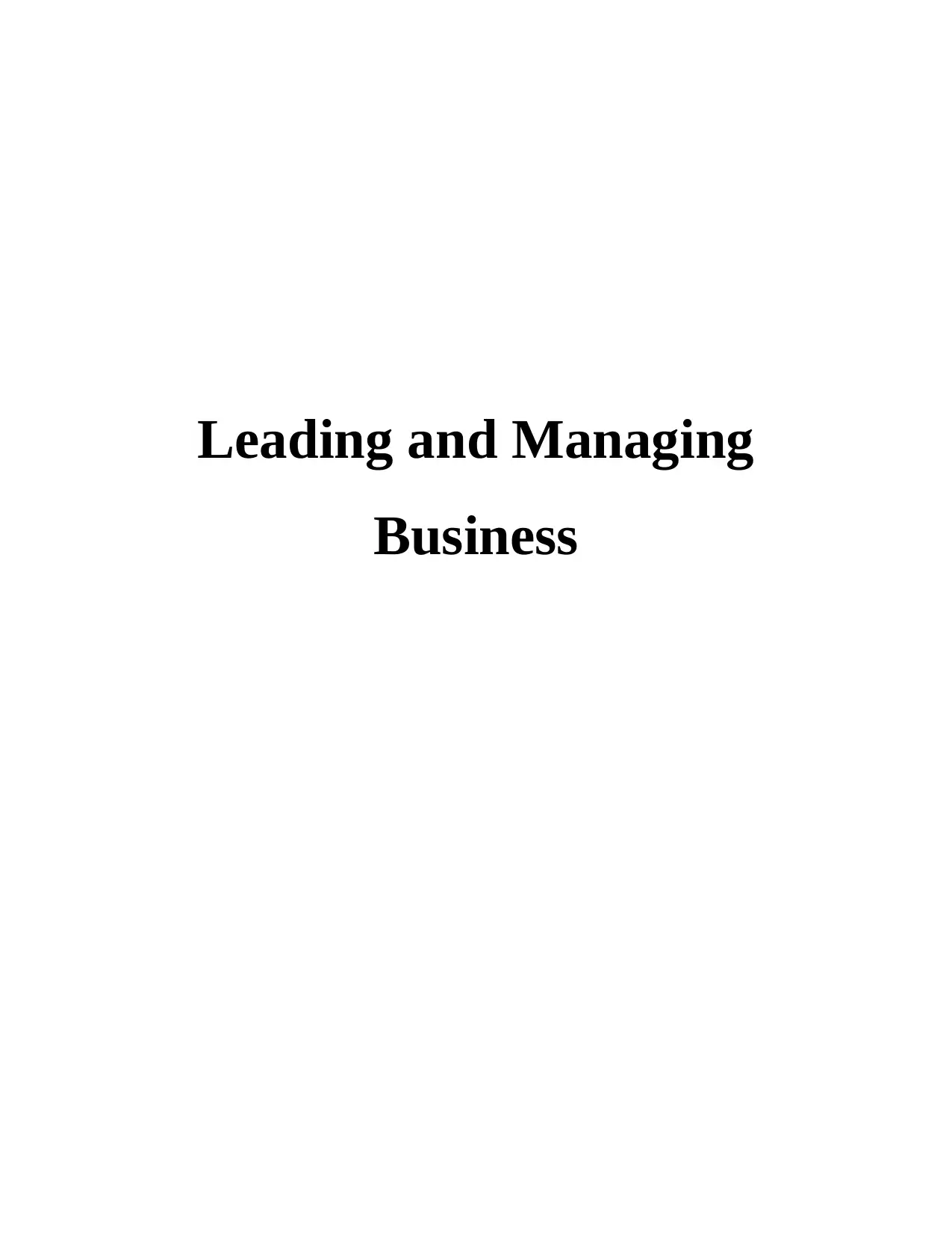
Leading and Managing
Business
Business
Paraphrase This Document
Need a fresh take? Get an instant paraphrase of this document with our AI Paraphraser
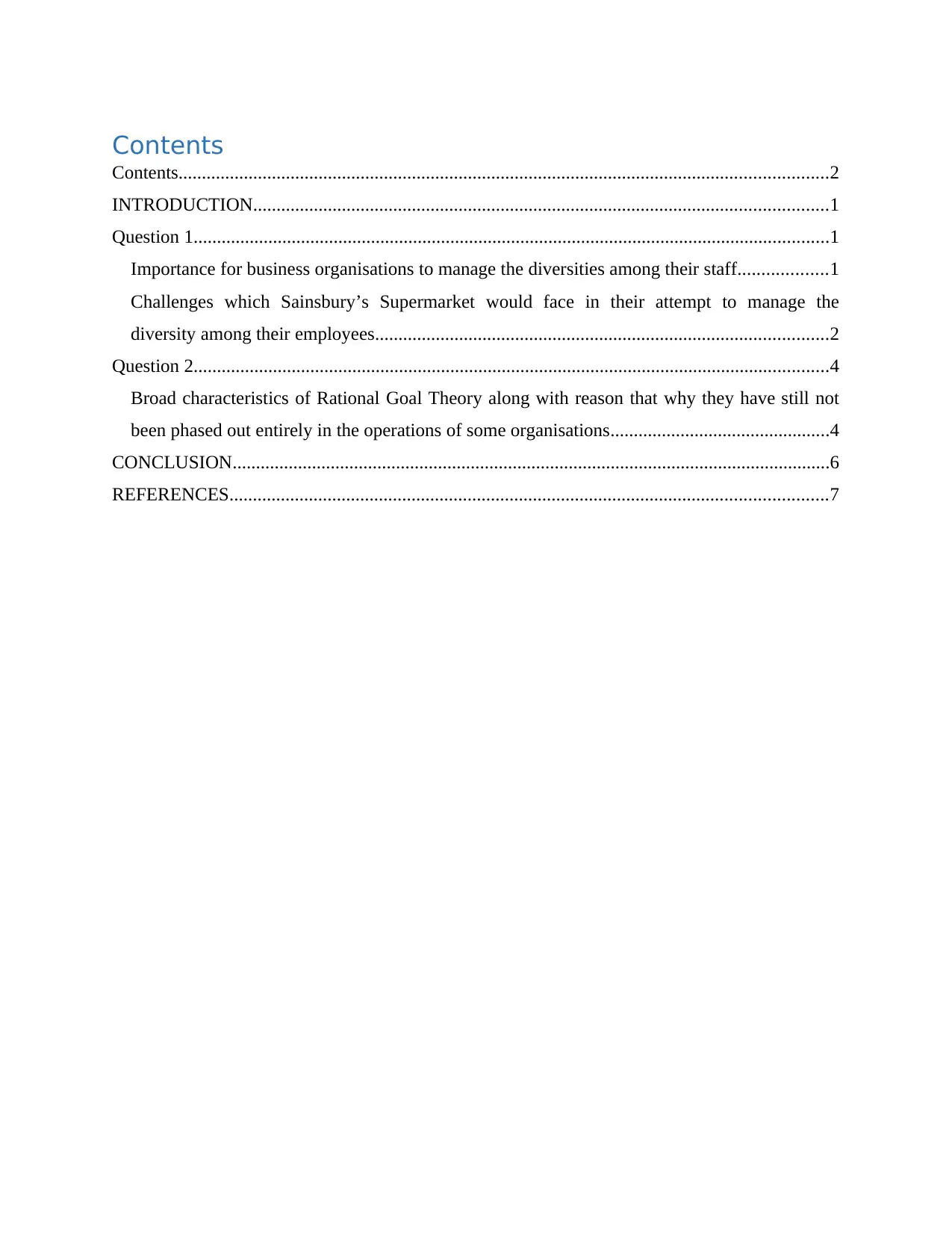
Contents
Contents...........................................................................................................................................2
INTRODUCTION...........................................................................................................................1
Question 1........................................................................................................................................1
Importance for business organisations to manage the diversities among their staff...................1
Challenges which Sainsbury’s Supermarket would face in their attempt to manage the
diversity among their employees.................................................................................................2
Question 2........................................................................................................................................4
Broad characteristics of Rational Goal Theory along with reason that why they have still not
been phased out entirely in the operations of some organisations...............................................4
CONCLUSION................................................................................................................................6
REFERENCES................................................................................................................................7
Contents...........................................................................................................................................2
INTRODUCTION...........................................................................................................................1
Question 1........................................................................................................................................1
Importance for business organisations to manage the diversities among their staff...................1
Challenges which Sainsbury’s Supermarket would face in their attempt to manage the
diversity among their employees.................................................................................................2
Question 2........................................................................................................................................4
Broad characteristics of Rational Goal Theory along with reason that why they have still not
been phased out entirely in the operations of some organisations...............................................4
CONCLUSION................................................................................................................................6
REFERENCES................................................................................................................................7

⊘ This is a preview!⊘
Do you want full access?
Subscribe today to unlock all pages.

Trusted by 1+ million students worldwide
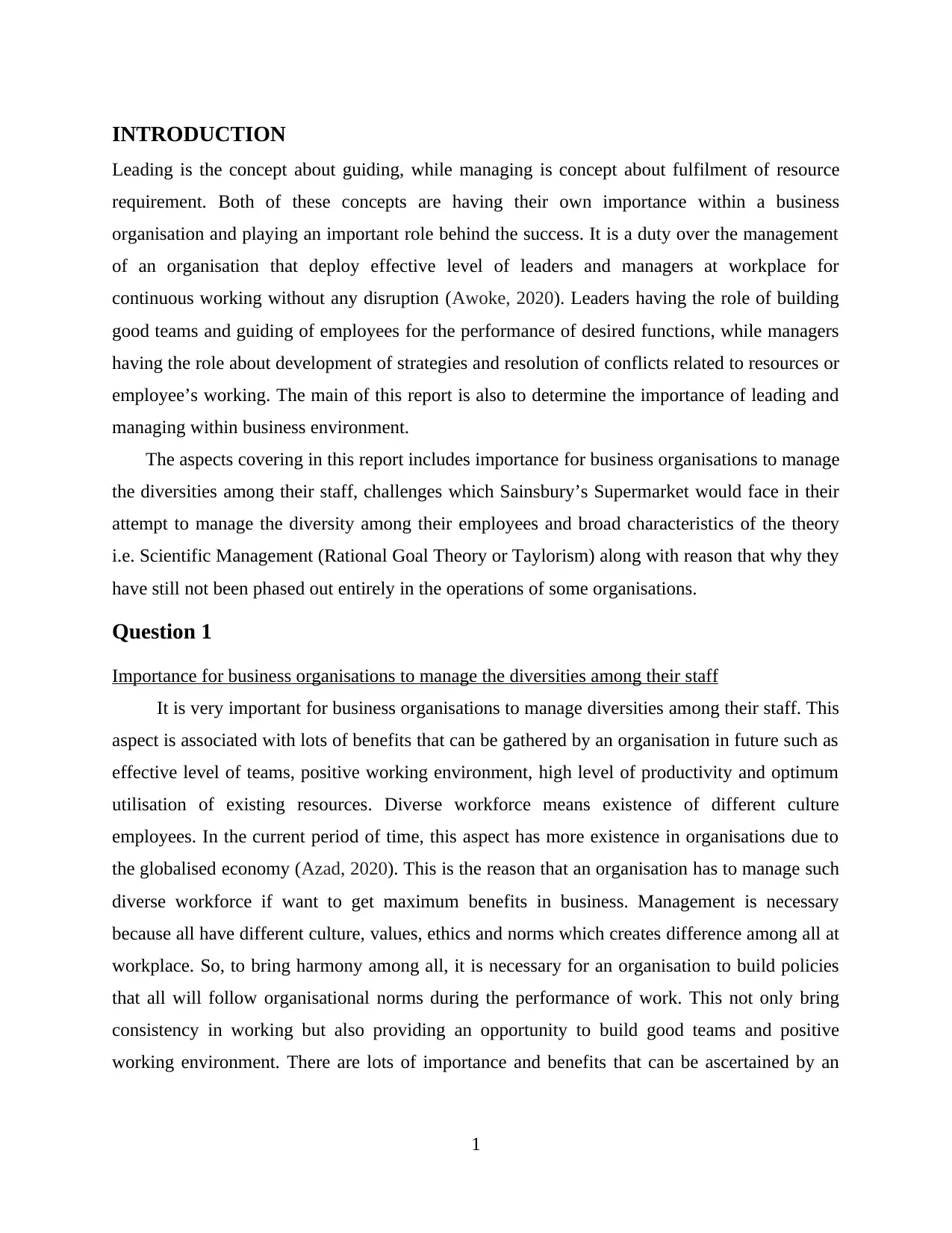
INTRODUCTION
Leading is the concept about guiding, while managing is concept about fulfilment of resource
requirement. Both of these concepts are having their own importance within a business
organisation and playing an important role behind the success. It is a duty over the management
of an organisation that deploy effective level of leaders and managers at workplace for
continuous working without any disruption (Awoke, 2020). Leaders having the role of building
good teams and guiding of employees for the performance of desired functions, while managers
having the role about development of strategies and resolution of conflicts related to resources or
employee’s working. The main of this report is also to determine the importance of leading and
managing within business environment.
The aspects covering in this report includes importance for business organisations to manage
the diversities among their staff, challenges which Sainsbury’s Supermarket would face in their
attempt to manage the diversity among their employees and broad characteristics of the theory
i.e. Scientific Management (Rational Goal Theory or Taylorism) along with reason that why they
have still not been phased out entirely in the operations of some organisations.
Question 1
Importance for business organisations to manage the diversities among their staff
It is very important for business organisations to manage diversities among their staff. This
aspect is associated with lots of benefits that can be gathered by an organisation in future such as
effective level of teams, positive working environment, high level of productivity and optimum
utilisation of existing resources. Diverse workforce means existence of different culture
employees. In the current period of time, this aspect has more existence in organisations due to
the globalised economy (Azad, 2020). This is the reason that an organisation has to manage such
diverse workforce if want to get maximum benefits in business. Management is necessary
because all have different culture, values, ethics and norms which creates difference among all at
workplace. So, to bring harmony among all, it is necessary for an organisation to build policies
that all will follow organisational norms during the performance of work. This not only bring
consistency in working but also providing an opportunity to build good teams and positive
working environment. There are lots of importance and benefits that can be ascertained by an
1
Leading is the concept about guiding, while managing is concept about fulfilment of resource
requirement. Both of these concepts are having their own importance within a business
organisation and playing an important role behind the success. It is a duty over the management
of an organisation that deploy effective level of leaders and managers at workplace for
continuous working without any disruption (Awoke, 2020). Leaders having the role of building
good teams and guiding of employees for the performance of desired functions, while managers
having the role about development of strategies and resolution of conflicts related to resources or
employee’s working. The main of this report is also to determine the importance of leading and
managing within business environment.
The aspects covering in this report includes importance for business organisations to manage
the diversities among their staff, challenges which Sainsbury’s Supermarket would face in their
attempt to manage the diversity among their employees and broad characteristics of the theory
i.e. Scientific Management (Rational Goal Theory or Taylorism) along with reason that why they
have still not been phased out entirely in the operations of some organisations.
Question 1
Importance for business organisations to manage the diversities among their staff
It is very important for business organisations to manage diversities among their staff. This
aspect is associated with lots of benefits that can be gathered by an organisation in future such as
effective level of teams, positive working environment, high level of productivity and optimum
utilisation of existing resources. Diverse workforce means existence of different culture
employees. In the current period of time, this aspect has more existence in organisations due to
the globalised economy (Azad, 2020). This is the reason that an organisation has to manage such
diverse workforce if want to get maximum benefits in business. Management is necessary
because all have different culture, values, ethics and norms which creates difference among all at
workplace. So, to bring harmony among all, it is necessary for an organisation to build policies
that all will follow organisational norms during the performance of work. This not only bring
consistency in working but also providing an opportunity to build good teams and positive
working environment. There are lots of importance and benefits that can be ascertained by an
1
Paraphrase This Document
Need a fresh take? Get an instant paraphrase of this document with our AI Paraphraser
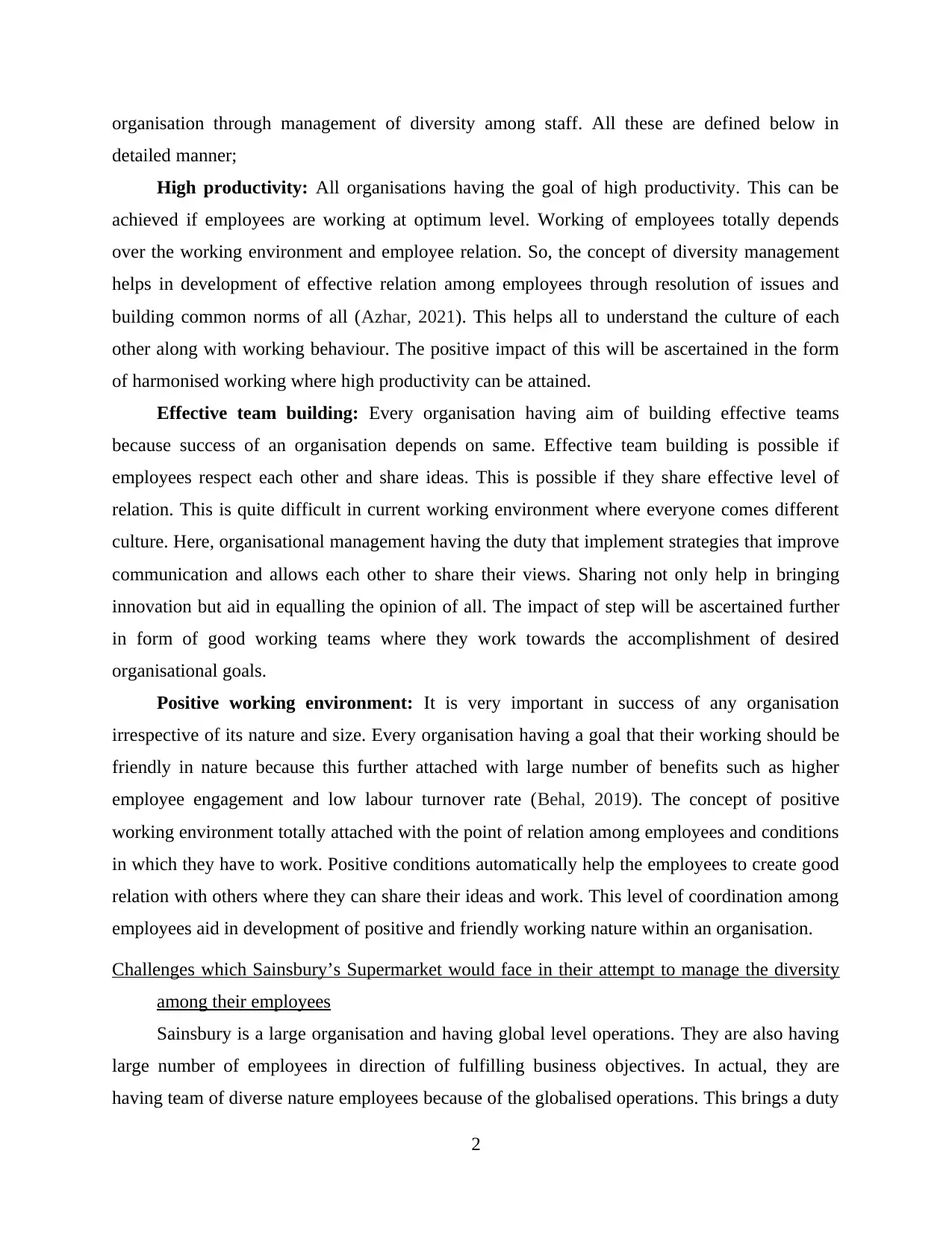
organisation through management of diversity among staff. All these are defined below in
detailed manner;
High productivity: All organisations having the goal of high productivity. This can be
achieved if employees are working at optimum level. Working of employees totally depends
over the working environment and employee relation. So, the concept of diversity management
helps in development of effective relation among employees through resolution of issues and
building common norms of all (Azhar, 2021). This helps all to understand the culture of each
other along with working behaviour. The positive impact of this will be ascertained in the form
of harmonised working where high productivity can be attained.
Effective team building: Every organisation having aim of building effective teams
because success of an organisation depends on same. Effective team building is possible if
employees respect each other and share ideas. This is possible if they share effective level of
relation. This is quite difficult in current working environment where everyone comes different
culture. Here, organisational management having the duty that implement strategies that improve
communication and allows each other to share their views. Sharing not only help in bringing
innovation but aid in equalling the opinion of all. The impact of step will be ascertained further
in form of good working teams where they work towards the accomplishment of desired
organisational goals.
Positive working environment: It is very important in success of any organisation
irrespective of its nature and size. Every organisation having a goal that their working should be
friendly in nature because this further attached with large number of benefits such as higher
employee engagement and low labour turnover rate (Behal, 2019). The concept of positive
working environment totally attached with the point of relation among employees and conditions
in which they have to work. Positive conditions automatically help the employees to create good
relation with others where they can share their ideas and work. This level of coordination among
employees aid in development of positive and friendly working nature within an organisation.
Challenges which Sainsbury’s Supermarket would face in their attempt to manage the diversity
among their employees
Sainsbury is a large organisation and having global level operations. They are also having
large number of employees in direction of fulfilling business objectives. In actual, they are
having team of diverse nature employees because of the globalised operations. This brings a duty
2
detailed manner;
High productivity: All organisations having the goal of high productivity. This can be
achieved if employees are working at optimum level. Working of employees totally depends
over the working environment and employee relation. So, the concept of diversity management
helps in development of effective relation among employees through resolution of issues and
building common norms of all (Azhar, 2021). This helps all to understand the culture of each
other along with working behaviour. The positive impact of this will be ascertained in the form
of harmonised working where high productivity can be attained.
Effective team building: Every organisation having aim of building effective teams
because success of an organisation depends on same. Effective team building is possible if
employees respect each other and share ideas. This is possible if they share effective level of
relation. This is quite difficult in current working environment where everyone comes different
culture. Here, organisational management having the duty that implement strategies that improve
communication and allows each other to share their views. Sharing not only help in bringing
innovation but aid in equalling the opinion of all. The impact of step will be ascertained further
in form of good working teams where they work towards the accomplishment of desired
organisational goals.
Positive working environment: It is very important in success of any organisation
irrespective of its nature and size. Every organisation having a goal that their working should be
friendly in nature because this further attached with large number of benefits such as higher
employee engagement and low labour turnover rate (Behal, 2019). The concept of positive
working environment totally attached with the point of relation among employees and conditions
in which they have to work. Positive conditions automatically help the employees to create good
relation with others where they can share their ideas and work. This level of coordination among
employees aid in development of positive and friendly working nature within an organisation.
Challenges which Sainsbury’s Supermarket would face in their attempt to manage the diversity
among their employees
Sainsbury is a large organisation and having global level operations. They are also having
large number of employees in direction of fulfilling business objectives. In actual, they are
having team of diverse nature employees because of the globalised operations. This brings a duty
2
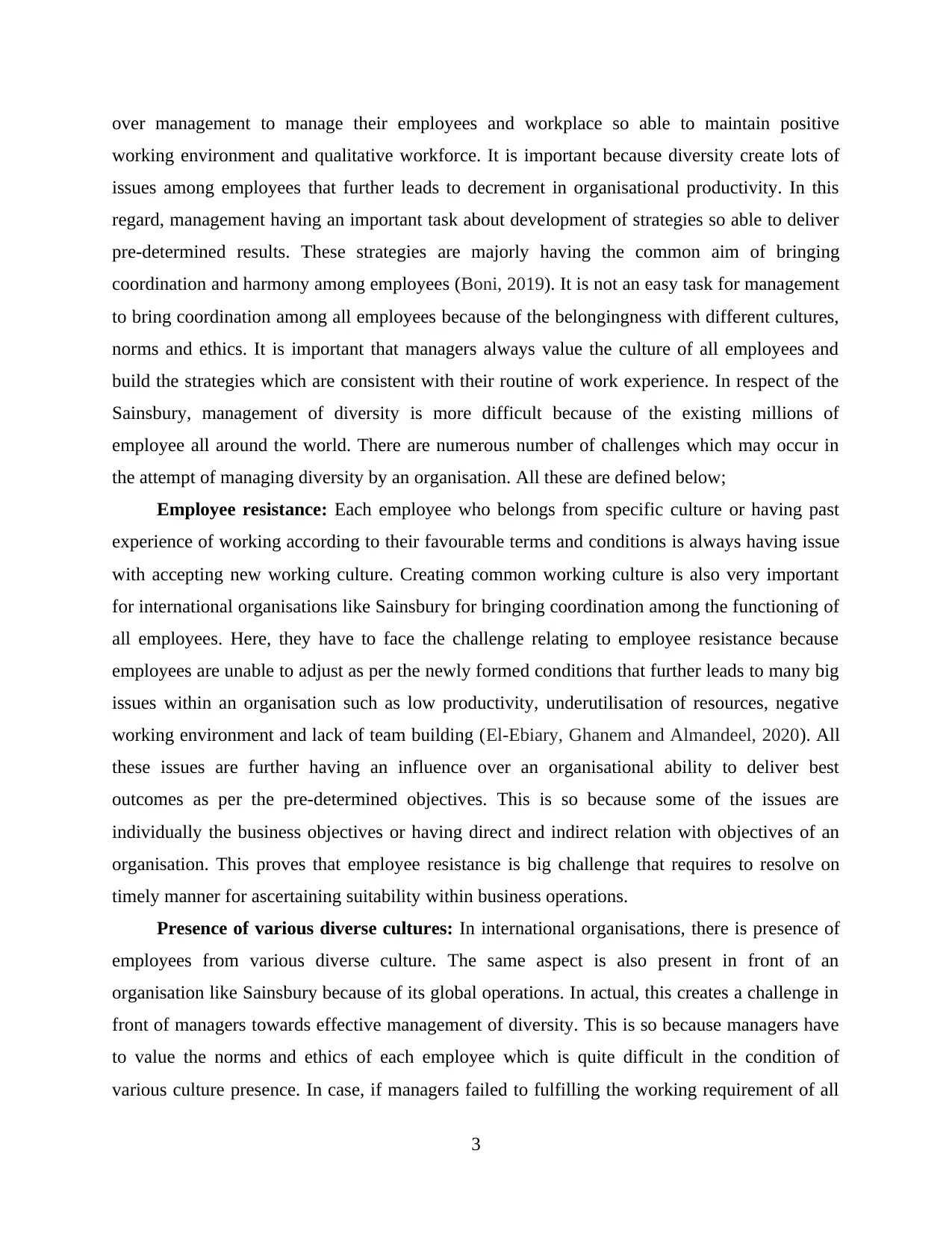
over management to manage their employees and workplace so able to maintain positive
working environment and qualitative workforce. It is important because diversity create lots of
issues among employees that further leads to decrement in organisational productivity. In this
regard, management having an important task about development of strategies so able to deliver
pre-determined results. These strategies are majorly having the common aim of bringing
coordination and harmony among employees (Boni, 2019). It is not an easy task for management
to bring coordination among all employees because of the belongingness with different cultures,
norms and ethics. It is important that managers always value the culture of all employees and
build the strategies which are consistent with their routine of work experience. In respect of the
Sainsbury, management of diversity is more difficult because of the existing millions of
employee all around the world. There are numerous number of challenges which may occur in
the attempt of managing diversity by an organisation. All these are defined below;
Employee resistance: Each employee who belongs from specific culture or having past
experience of working according to their favourable terms and conditions is always having issue
with accepting new working culture. Creating common working culture is also very important
for international organisations like Sainsbury for bringing coordination among the functioning of
all employees. Here, they have to face the challenge relating to employee resistance because
employees are unable to adjust as per the newly formed conditions that further leads to many big
issues within an organisation such as low productivity, underutilisation of resources, negative
working environment and lack of team building (El-Ebiary, Ghanem and Almandeel, 2020). All
these issues are further having an influence over an organisational ability to deliver best
outcomes as per the pre-determined objectives. This is so because some of the issues are
individually the business objectives or having direct and indirect relation with objectives of an
organisation. This proves that employee resistance is big challenge that requires to resolve on
timely manner for ascertaining suitability within business operations.
Presence of various diverse cultures: In international organisations, there is presence of
employees from various diverse culture. The same aspect is also present in front of an
organisation like Sainsbury because of its global operations. In actual, this creates a challenge in
front of managers towards effective management of diversity. This is so because managers have
to value the norms and ethics of each employee which is quite difficult in the condition of
various culture presence. In case, if managers failed to fulfilling the working requirement of all
3
working environment and qualitative workforce. It is important because diversity create lots of
issues among employees that further leads to decrement in organisational productivity. In this
regard, management having an important task about development of strategies so able to deliver
pre-determined results. These strategies are majorly having the common aim of bringing
coordination and harmony among employees (Boni, 2019). It is not an easy task for management
to bring coordination among all employees because of the belongingness with different cultures,
norms and ethics. It is important that managers always value the culture of all employees and
build the strategies which are consistent with their routine of work experience. In respect of the
Sainsbury, management of diversity is more difficult because of the existing millions of
employee all around the world. There are numerous number of challenges which may occur in
the attempt of managing diversity by an organisation. All these are defined below;
Employee resistance: Each employee who belongs from specific culture or having past
experience of working according to their favourable terms and conditions is always having issue
with accepting new working culture. Creating common working culture is also very important
for international organisations like Sainsbury for bringing coordination among the functioning of
all employees. Here, they have to face the challenge relating to employee resistance because
employees are unable to adjust as per the newly formed conditions that further leads to many big
issues within an organisation such as low productivity, underutilisation of resources, negative
working environment and lack of team building (El-Ebiary, Ghanem and Almandeel, 2020). All
these issues are further having an influence over an organisational ability to deliver best
outcomes as per the pre-determined objectives. This is so because some of the issues are
individually the business objectives or having direct and indirect relation with objectives of an
organisation. This proves that employee resistance is big challenge that requires to resolve on
timely manner for ascertaining suitability within business operations.
Presence of various diverse cultures: In international organisations, there is presence of
employees from various diverse culture. The same aspect is also present in front of an
organisation like Sainsbury because of its global operations. In actual, this creates a challenge in
front of managers towards effective management of diversity. This is so because managers have
to value the norms and ethics of each employee which is quite difficult in the condition of
various culture presence. In case, if managers failed to fulfilling the working requirement of all
3
⊘ This is a preview!⊘
Do you want full access?
Subscribe today to unlock all pages.

Trusted by 1+ million students worldwide
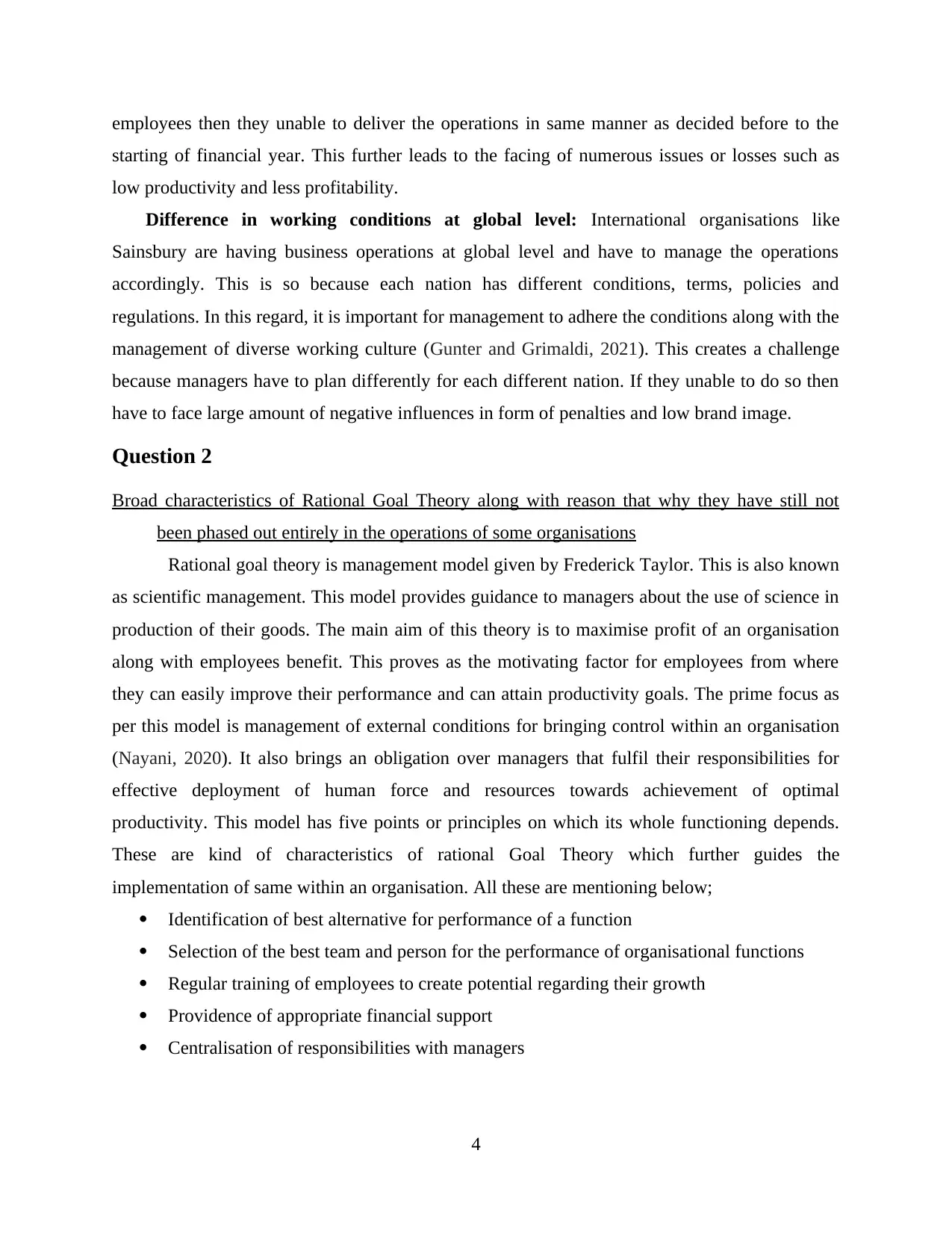
employees then they unable to deliver the operations in same manner as decided before to the
starting of financial year. This further leads to the facing of numerous issues or losses such as
low productivity and less profitability.
Difference in working conditions at global level: International organisations like
Sainsbury are having business operations at global level and have to manage the operations
accordingly. This is so because each nation has different conditions, terms, policies and
regulations. In this regard, it is important for management to adhere the conditions along with the
management of diverse working culture (Gunter and Grimaldi, 2021). This creates a challenge
because managers have to plan differently for each different nation. If they unable to do so then
have to face large amount of negative influences in form of penalties and low brand image.
Question 2
Broad characteristics of Rational Goal Theory along with reason that why they have still not
been phased out entirely in the operations of some organisations
Rational goal theory is management model given by Frederick Taylor. This is also known
as scientific management. This model provides guidance to managers about the use of science in
production of their goods. The main aim of this theory is to maximise profit of an organisation
along with employees benefit. This proves as the motivating factor for employees from where
they can easily improve their performance and can attain productivity goals. The prime focus as
per this model is management of external conditions for bringing control within an organisation
(Nayani, 2020). It also brings an obligation over managers that fulfil their responsibilities for
effective deployment of human force and resources towards achievement of optimal
productivity. This model has five points or principles on which its whole functioning depends.
These are kind of characteristics of rational Goal Theory which further guides the
implementation of same within an organisation. All these are mentioning below;
Identification of best alternative for performance of a function
Selection of the best team and person for the performance of organisational functions
Regular training of employees to create potential regarding their growth
Providence of appropriate financial support
Centralisation of responsibilities with managers
4
starting of financial year. This further leads to the facing of numerous issues or losses such as
low productivity and less profitability.
Difference in working conditions at global level: International organisations like
Sainsbury are having business operations at global level and have to manage the operations
accordingly. This is so because each nation has different conditions, terms, policies and
regulations. In this regard, it is important for management to adhere the conditions along with the
management of diverse working culture (Gunter and Grimaldi, 2021). This creates a challenge
because managers have to plan differently for each different nation. If they unable to do so then
have to face large amount of negative influences in form of penalties and low brand image.
Question 2
Broad characteristics of Rational Goal Theory along with reason that why they have still not
been phased out entirely in the operations of some organisations
Rational goal theory is management model given by Frederick Taylor. This is also known
as scientific management. This model provides guidance to managers about the use of science in
production of their goods. The main aim of this theory is to maximise profit of an organisation
along with employees benefit. This proves as the motivating factor for employees from where
they can easily improve their performance and can attain productivity goals. The prime focus as
per this model is management of external conditions for bringing control within an organisation
(Nayani, 2020). It also brings an obligation over managers that fulfil their responsibilities for
effective deployment of human force and resources towards achievement of optimal
productivity. This model has five points or principles on which its whole functioning depends.
These are kind of characteristics of rational Goal Theory which further guides the
implementation of same within an organisation. All these are mentioning below;
Identification of best alternative for performance of a function
Selection of the best team and person for the performance of organisational functions
Regular training of employees to create potential regarding their growth
Providence of appropriate financial support
Centralisation of responsibilities with managers
4
Paraphrase This Document
Need a fresh take? Get an instant paraphrase of this document with our AI Paraphraser
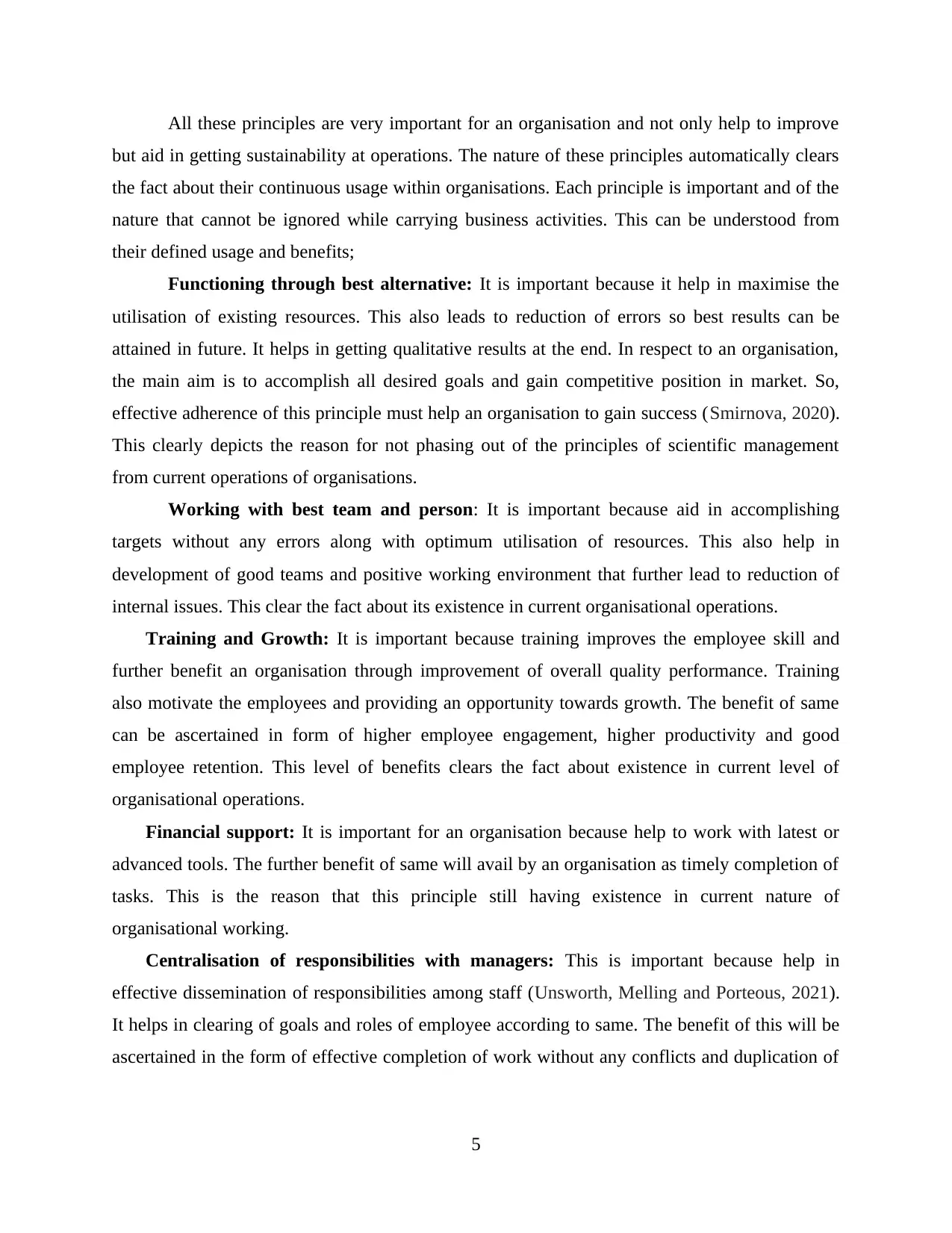
All these principles are very important for an organisation and not only help to improve
but aid in getting sustainability at operations. The nature of these principles automatically clears
the fact about their continuous usage within organisations. Each principle is important and of the
nature that cannot be ignored while carrying business activities. This can be understood from
their defined usage and benefits;
Functioning through best alternative: It is important because it help in maximise the
utilisation of existing resources. This also leads to reduction of errors so best results can be
attained in future. It helps in getting qualitative results at the end. In respect to an organisation,
the main aim is to accomplish all desired goals and gain competitive position in market. So,
effective adherence of this principle must help an organisation to gain success (Smirnova, 2020).
This clearly depicts the reason for not phasing out of the principles of scientific management
from current operations of organisations.
Working with best team and person: It is important because aid in accomplishing
targets without any errors along with optimum utilisation of resources. This also help in
development of good teams and positive working environment that further lead to reduction of
internal issues. This clear the fact about its existence in current organisational operations.
Training and Growth: It is important because training improves the employee skill and
further benefit an organisation through improvement of overall quality performance. Training
also motivate the employees and providing an opportunity towards growth. The benefit of same
can be ascertained in form of higher employee engagement, higher productivity and good
employee retention. This level of benefits clears the fact about existence in current level of
organisational operations.
Financial support: It is important for an organisation because help to work with latest or
advanced tools. The further benefit of same will avail by an organisation as timely completion of
tasks. This is the reason that this principle still having existence in current nature of
organisational working.
Centralisation of responsibilities with managers: This is important because help in
effective dissemination of responsibilities among staff (Unsworth, Melling and Porteous, 2021).
It helps in clearing of goals and roles of employee according to same. The benefit of this will be
ascertained in the form of effective completion of work without any conflicts and duplication of
5
but aid in getting sustainability at operations. The nature of these principles automatically clears
the fact about their continuous usage within organisations. Each principle is important and of the
nature that cannot be ignored while carrying business activities. This can be understood from
their defined usage and benefits;
Functioning through best alternative: It is important because it help in maximise the
utilisation of existing resources. This also leads to reduction of errors so best results can be
attained in future. It helps in getting qualitative results at the end. In respect to an organisation,
the main aim is to accomplish all desired goals and gain competitive position in market. So,
effective adherence of this principle must help an organisation to gain success (Smirnova, 2020).
This clearly depicts the reason for not phasing out of the principles of scientific management
from current operations of organisations.
Working with best team and person: It is important because aid in accomplishing
targets without any errors along with optimum utilisation of resources. This also help in
development of good teams and positive working environment that further lead to reduction of
internal issues. This clear the fact about its existence in current organisational operations.
Training and Growth: It is important because training improves the employee skill and
further benefit an organisation through improvement of overall quality performance. Training
also motivate the employees and providing an opportunity towards growth. The benefit of same
can be ascertained in form of higher employee engagement, higher productivity and good
employee retention. This level of benefits clears the fact about existence in current level of
organisational operations.
Financial support: It is important for an organisation because help to work with latest or
advanced tools. The further benefit of same will avail by an organisation as timely completion of
tasks. This is the reason that this principle still having existence in current nature of
organisational working.
Centralisation of responsibilities with managers: This is important because help in
effective dissemination of responsibilities among staff (Unsworth, Melling and Porteous, 2021).
It helps in clearing of goals and roles of employee according to same. The benefit of this will be
ascertained in the form of effective completion of work without any conflicts and duplication of
5
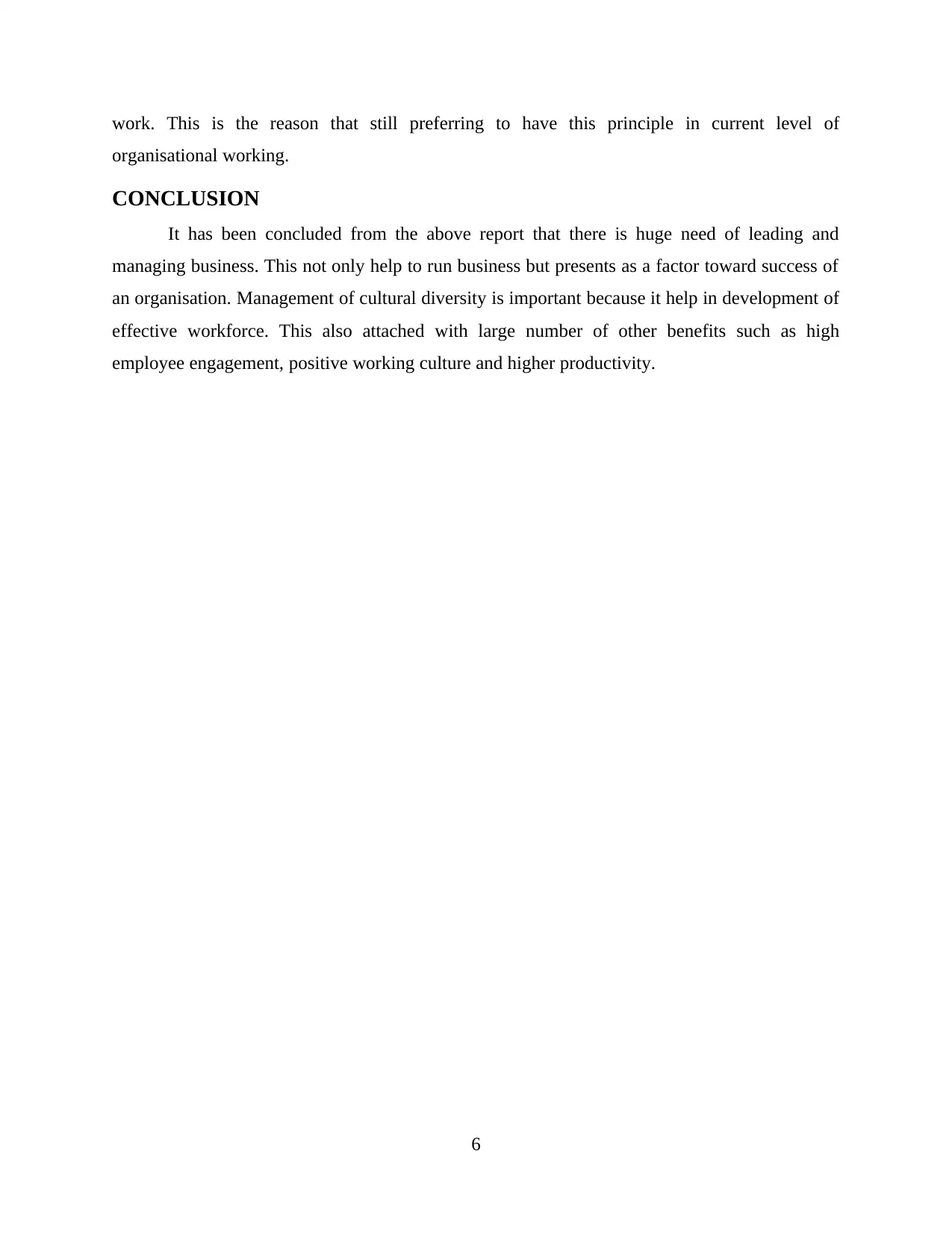
work. This is the reason that still preferring to have this principle in current level of
organisational working.
CONCLUSION
It has been concluded from the above report that there is huge need of leading and
managing business. This not only help to run business but presents as a factor toward success of
an organisation. Management of cultural diversity is important because it help in development of
effective workforce. This also attached with large number of other benefits such as high
employee engagement, positive working culture and higher productivity.
6
organisational working.
CONCLUSION
It has been concluded from the above report that there is huge need of leading and
managing business. This not only help to run business but presents as a factor toward success of
an organisation. Management of cultural diversity is important because it help in development of
effective workforce. This also attached with large number of other benefits such as high
employee engagement, positive working culture and higher productivity.
6
⊘ This is a preview!⊘
Do you want full access?
Subscribe today to unlock all pages.

Trusted by 1+ million students worldwide
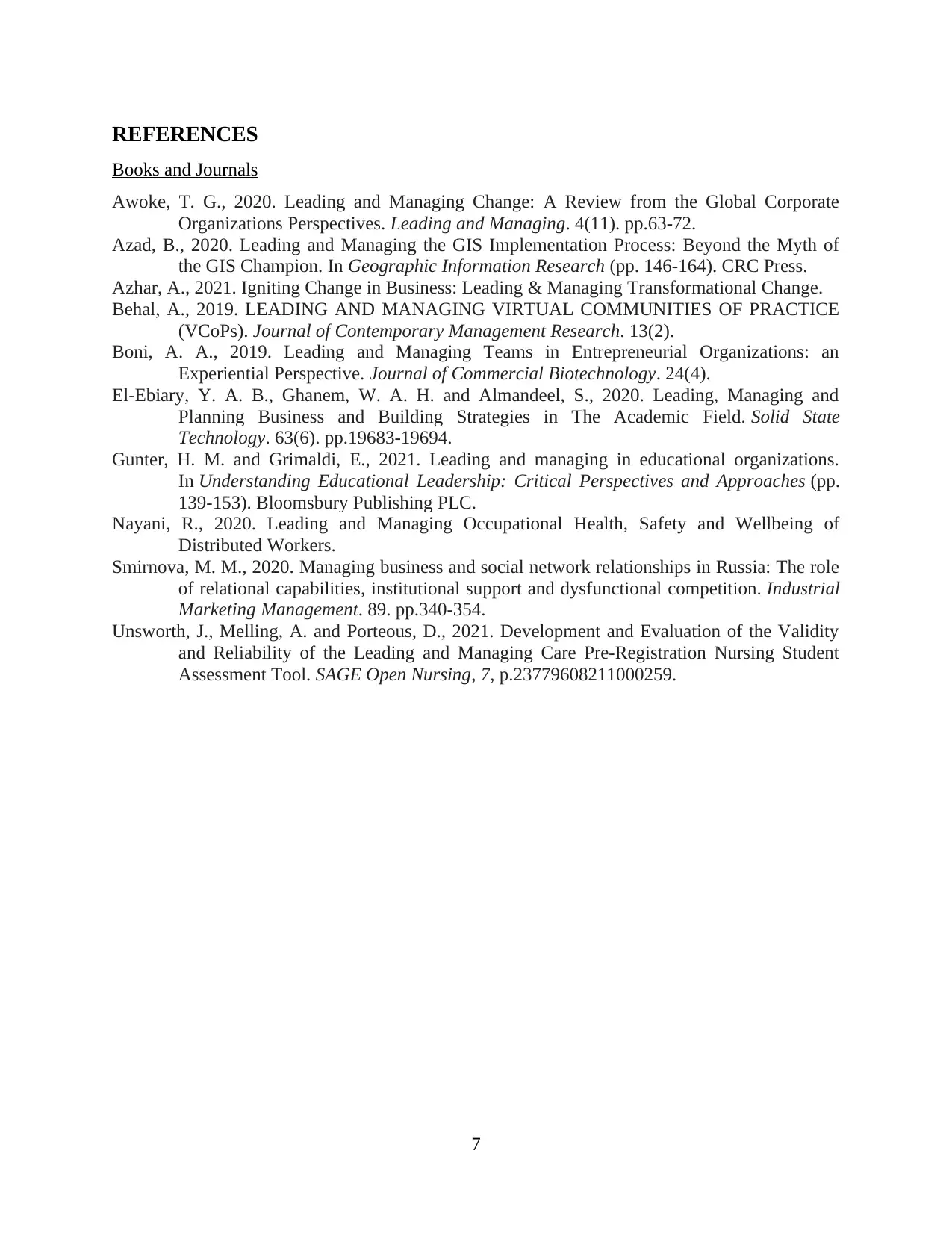
REFERENCES
Books and Journals
Awoke, T. G., 2020. Leading and Managing Change: A Review from the Global Corporate
Organizations Perspectives. Leading and Managing. 4(11). pp.63-72.
Azad, B., 2020. Leading and Managing the GIS Implementation Process: Beyond the Myth of
the GIS Champion. In Geographic Information Research (pp. 146-164). CRC Press.
Azhar, A., 2021. Igniting Change in Business: Leading & Managing Transformational Change.
Behal, A., 2019. LEADING AND MANAGING VIRTUAL COMMUNITIES OF PRACTICE
(VCoPs). Journal of Contemporary Management Research. 13(2).
Boni, A. A., 2019. Leading and Managing Teams in Entrepreneurial Organizations: an
Experiential Perspective. Journal of Commercial Biotechnology. 24(4).
El-Ebiary, Y. A. B., Ghanem, W. A. H. and Almandeel, S., 2020. Leading, Managing and
Planning Business and Building Strategies in The Academic Field. Solid State
Technology. 63(6). pp.19683-19694.
Gunter, H. M. and Grimaldi, E., 2021. Leading and managing in educational organizations.
In Understanding Educational Leadership: Critical Perspectives and Approaches (pp.
139-153). Bloomsbury Publishing PLC.
Nayani, R., 2020. Leading and Managing Occupational Health, Safety and Wellbeing of
Distributed Workers.
Smirnova, M. M., 2020. Managing business and social network relationships in Russia: The role
of relational capabilities, institutional support and dysfunctional competition. Industrial
Marketing Management. 89. pp.340-354.
Unsworth, J., Melling, A. and Porteous, D., 2021. Development and Evaluation of the Validity
and Reliability of the Leading and Managing Care Pre-Registration Nursing Student
Assessment Tool. SAGE Open Nursing, 7, p.23779608211000259.
7
Books and Journals
Awoke, T. G., 2020. Leading and Managing Change: A Review from the Global Corporate
Organizations Perspectives. Leading and Managing. 4(11). pp.63-72.
Azad, B., 2020. Leading and Managing the GIS Implementation Process: Beyond the Myth of
the GIS Champion. In Geographic Information Research (pp. 146-164). CRC Press.
Azhar, A., 2021. Igniting Change in Business: Leading & Managing Transformational Change.
Behal, A., 2019. LEADING AND MANAGING VIRTUAL COMMUNITIES OF PRACTICE
(VCoPs). Journal of Contemporary Management Research. 13(2).
Boni, A. A., 2019. Leading and Managing Teams in Entrepreneurial Organizations: an
Experiential Perspective. Journal of Commercial Biotechnology. 24(4).
El-Ebiary, Y. A. B., Ghanem, W. A. H. and Almandeel, S., 2020. Leading, Managing and
Planning Business and Building Strategies in The Academic Field. Solid State
Technology. 63(6). pp.19683-19694.
Gunter, H. M. and Grimaldi, E., 2021. Leading and managing in educational organizations.
In Understanding Educational Leadership: Critical Perspectives and Approaches (pp.
139-153). Bloomsbury Publishing PLC.
Nayani, R., 2020. Leading and Managing Occupational Health, Safety and Wellbeing of
Distributed Workers.
Smirnova, M. M., 2020. Managing business and social network relationships in Russia: The role
of relational capabilities, institutional support and dysfunctional competition. Industrial
Marketing Management. 89. pp.340-354.
Unsworth, J., Melling, A. and Porteous, D., 2021. Development and Evaluation of the Validity
and Reliability of the Leading and Managing Care Pre-Registration Nursing Student
Assessment Tool. SAGE Open Nursing, 7, p.23779608211000259.
7
1 out of 10
Related Documents
Your All-in-One AI-Powered Toolkit for Academic Success.
+13062052269
info@desklib.com
Available 24*7 on WhatsApp / Email
![[object Object]](/_next/static/media/star-bottom.7253800d.svg)
Unlock your academic potential
Copyright © 2020–2025 A2Z Services. All Rights Reserved. Developed and managed by ZUCOL.





